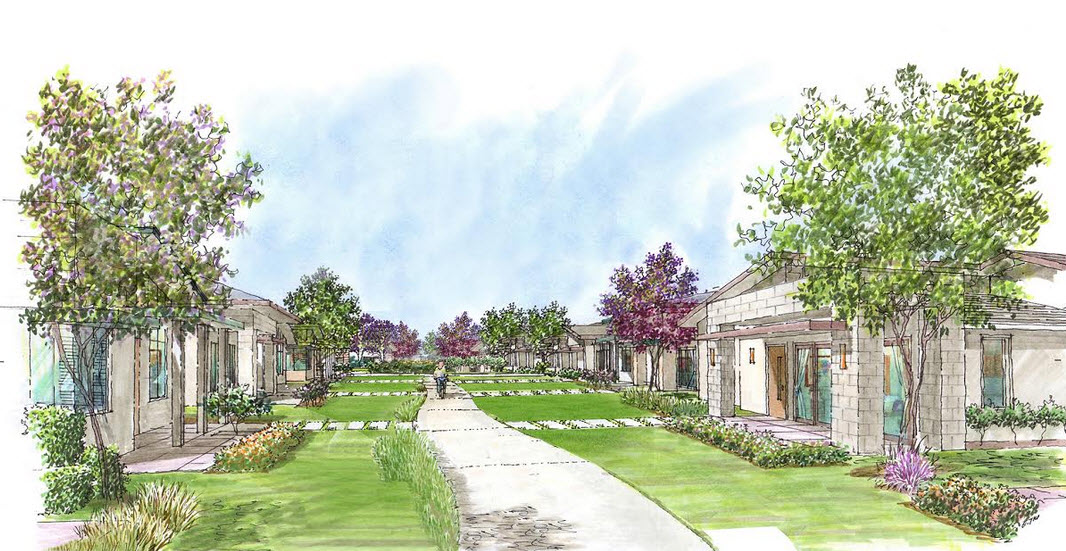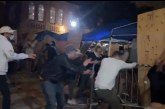
The West Davis Active Adult Community senior housing project goes to the Davis City Council for the first time on Tuesday. The council is not being asked to approve it for going on the November ballot at this time, but rather they will bring it back for action on June 12.
As the Vanguard has previously reported, the project is located directly west of Sutter-Davis Hospital on a 75-acre site. The 560-unit project would have 80 percent of the for-sale units restricted to those older than 55 with the other 20 percent unrestricted. There would also be around 150 apartments for those 62 or older.
According to the staff report, “Staff supports the 80:20 concept as a mechanism for supporting an intergenerational neighborhood while providing housing of a type requested by empty nesters. The City has needs for many types of affordable housing, including affordable housing for seniors, although seniors as a demographic group have a statistically lower proportion in poverty than other groups.”
Staff also “supports the affordable housing proposal, including the proposed age restriction, because of the deep targeting to extremely-low and very-low income households, and the provision of significantly more affordable units than would otherwise be required.”
The overall density of the development is 7.5 units per acre. Staff acknowledges, “This is lower than a density that would be desirable in a more central location. However, staff has concluded that the density is appropriate for the target demographic and this location on the edge of the community, given that the project also provides internal greenways and an agricultural buffer, a mixed-use component, and gathering areas.”
component, and gathering areas.”
In addition to concerns about restrictiveness and low density, there are challenges with connectivity.
Staff notes: “The site is challenged for access because it has Covell Boulevard, a major arterial, on the southern frontage and agricultural lands to the north and west.”
Here, “The project provides extensive aesthetic and safety improvements to Covell Boulevard, including reconstruction of the Covell/Shasta/Risling to conform with city standards, remove the free right movements, and shorten the distance for pedestrians and cyclists crossing Covell and Risling.”
Staff argues: “These improvements will serve residents of WDAAC and current West Davis residents accessing the hospital or Covell Boulevard bus stops. Space for a landing to accommodate a pedestrian/bicyclist crossing of SR-113 is also provided, should that be proposed in the future.”
Staff concludes, finding “the improvements to be an overall community benefit, and adequate to serve the needs of WDAAC residents.”
The Planning Commission heard this project in early April – it was the fourth time that Commission had a chance to discuss the project, with two previous workshops and a meeting to hear comments on the EIR.
There was extensive public comment – most of it supportive of the project.
The Planning Commission did not approve the Development Agreement. They had expressed general support for the proposal and the need for senior housing. Staff notes: “Commission discussion centered on the whether all of the affordable housing should be age-restricted, connectivity challenges, and access to amenities. The vote to not recommend approval of the Development Agreement because the draft presented to the Commission was very preliminary and did not represent the document anticipated for consideration by the City Council.”
Among the various key considerations is the fact that WDAAC would be the first age-restricted single-family subdivision in Davis. As noted it would be an 80-20 split and staff is supportive of the concept which they say is “consistent with state and federal law through identification of age-restricted and unrestricted parcels as part of the subdivision process.”
Nevertheless, “Commissioners and the public have questioned whether an age-restricted development is appropriate for development in Davis.”
On affordable housing, the project is required to have at least 60 units, but proposes as many as 150 affordable housing apartments on over four acres of land dedication.
Staff notes: “Because of the anticipated subsidy financing, occupancy is expected to be limited to residents aged 62 or over. Rents would be targeted to low-income, very-low-income, and extremely-low-income seniors.”
The land would be transferred to the city if the construction does not commence within three to five years.
A key question, however, is whether the affordable housing should be senior-only.
Staff writes: “The City has needs for many types of affordable housing, including affordable housing for seniors. Staff has explored with the applicant whether the affordable housing component should include units addressing other housing needs, and not just seniors. The applicant has stated that mixing seniors and non-seniors (such as a half-and-half development) would require duplication of common facilities and services, could be cost-prohibitive, and may cause security concerns for senior residents.”
The Finance and Budget Commission met on February 12 to discuss this project. While they did not have the development agreement at the time of discussion, the estimate by staff was a one-time benefit of $8.6 million in construction tax revenues and development impact fees. The commission found this “generally reasonable given the data currently available.”
They also concurred with the estimate that the “project would be significantly positive over its first 15 years of development, generating as much as a $300,000 net fiscal benefit in many years.”
—David M. Greenwald reporting







While its demographic is probably a bit older than the 80% at WDAAC, University Retirement Community is probably fairly representative of what modal share will be like at the planned development. At Celebrate Davis I spoke with a representative of University Retirement Community, across from the planned WDAAC.
I was told that very few people go Downtown by bicycle and obviously nearly no one by foot. People ride bikes, but for sport, and not to Downtown. But few walk to the Marketplace, across the Vic Fazio peak automobile sculpture that monopolizes a huge amount of land next to campus for people who for the most part don’t live, shop or even stop in Davis.
There is of course already a ped-bike bridge over CA-113 south of Covell and perhaps five minutes east of URC. This would be the most direct route towards Downtown… but it’s apparently not used by residents of URC. The proposed bridge to the area of Davis just north of the Marketplace would have more of a recreational focus than the aforementioned bridge, and there’s no actual plan for it.
The Draft EIR for WDAAC projected a less than 3% not by car modal share. I commented on this and in the Final EIR response was told that this was conservative and that some improvements to e.g. Covell – mentioned above – would help. I guessed that half of 3% would leave WDAAC by bicycle: 1.5% is 1/20 the bicycle modal share goal for Davis – in the Beyond Platinum Plan, approved by Council in 2014 – for two years for now. Let’s say that adding some crossing improvements to West Covell – and also the planned widening west of WDAAC – miraculously doubles that figure: It’s still 1/10 of the goal. Let’s agree that modal share in Davis for the combined WDAAC 80/20 demographic can be expected to have a 10% modal share overall; this makes the likely WDAAC share less than 1/3 of the goal. Check out bike parking at the Marketplace now: Maybe ten bikes total out of hundreds of cars, and there are a lot of students in the area. I am certain that fewer than 10% of trips to campus or middle schools are by bike. It’s the bad spatial layout and free parking!
WDAAC is a proposed low-density peripheral elder ghetto. It’s absurd that it’s even being considered, despite the great need for elder-appropriate housing (and affordable housing). It’s too far from everything and will encourage elders to drive later in their lives than they should. It’s too far to visit spontaneously – especially by bike – unless one lives in West and northwestern parts of Davis. Few Davis kids visiting grandma after school or on the weekend … by bike.
There’s no guarantee that any of the Davis homes made available because of moves to WDAAC won’t go to people not originally from Davis, who may then commute to Sacramento or beyond once they live here.
WDAAC – as planned – is a disaster.
There are great things happening with the Downtown Plan process: The experts involved understand very well how walkability benefits all age groups. There will need to be elder-focused housing in the Downtown itself, but an additional location right next to will be able to have a higher proportion of elders, since it’s on land owned by the City of Davis. This is the Civic Plaza area between A and B, 5th to 7th, plus B to C, 5th to 6th. A process to make it the Central Davis Active Adult Community directly integrated with other communities – families, low-income, students – needs to start immediately. Most of what’s good about WDAAC can happen here.
I’ve previously expressed my opinions on this ill-advised proposal, so I won’t reiterate them here. For anyone interested: Guest Commentary: Just Say No to Age-Restricted Housing.
I would note here that there’s no mention of the absurd proposed Davis-Based Buyer’s Program in the City staff report (or this article). I also want to emphasize that my objections to WDAAC have nothing to do with assisted living facilities or other special needs housing.
It appears to have no made the cut.
But the Enterprise is still repeating the BS about seniors moving out of large houses and into assisted living. Clearly the WDAAC people wrote the editorial for them.
That’s not precluded. That’s the theory of their project that seniors want to downsize.
Just marketing and as valid as advertisements that drinking a certain cola will make you more attractive.
“That’s the theory of their project that seniors want to downsize”
So your logic is, don’t provide housing for seniors because someone from outside Davis might move it?